Duchamp, Manzoni, Lewitt, Craig-Martin, Gilbert and George
Conceptual art, an art form which established itself in the 1960s but saw its roots back in the early twentieth century with the dada movement and Marcel Duchamp. But why did it take so long for the movement to come to complete fruition? Easy answer, the timing was not right. The artists who moved to the states from Europe in an attempt to flee World War One were interrupted by a new wave of artists who fled Europe from World War Two. With this came the rise of abstract expressionism and pop art. Both of these were very important in the creation of a movement that would change the art world forever. After world war two, America was in a state of feeling victorious and powerful over the world, of course it was the beginning of a new world power. With this confidence grew a thriving for more knowledge and a desire to enhance the nation that had done so well in the two previous wars. All cultural activities were to delight in more money being spent on their development, and the critic world which we know today was born. One critic, Clement Greenberg was so influential he split the art world, dividing it into its medium genres. Painting being dominant at the time was given much more attention than the less popular sculpture. Because of this, painting became incredibly self-reflective and self-referential. It formed into a formal action, mainly counting on its aesthetic value to get it any publicity.
At the same time a group of artists was forming under the term fluxus. These artists were not interested in the traditional ways of expressing oneself but were into more unconventional methods such as dance, performance art, music amongst others. Although these had been seen before, never had they been considered art in a gallery format. With this came the questioning of the purpose of the gallery and a wish to break away and elude the art market. Conceptual art was born. The artists were not first interested in making paintings but decided on whatever materials and form was appropriate to the concept. This overcoming of medium and the task of putting the idea first is the origin of conceptual art. Although the art was growing in popularity around the early sixties, the term wasn’t coined until Sol Lewitt wrote “Paragraphs on conceptual art” were he explains the type of art he was generating. This was published in the June, 1967 edition of ArtForum Magazine, a significant international art magazine still around today.
So let’s begin with Marcel Duchamp, who can be considered as one of the most important artists of the twentieth century. His controversial work and stunning concepts behind the work took the art scene by storm and turned it upside down, he raised questions about the aesthetics of art, the importance of the craftsmanship of the artist, the idea that the artist did not even need to make the work and maybe the most important of all he questioned what is art? What was its purpose in modern day society?
Marcel Duchamp was born in 1887 into an incredibly creative family. His older brothers were to become famous artists themselves; the sculptor, Raymond Duchamp-Villon and painter, Jacques Villon. At an early age, Duchamp worked in a fauvist style, being inspired by painters such as Andre Derain and Matisse but eventually moved onto a more cubist approach. His depiction of cubism was very different to the other examples of work under the movement’s 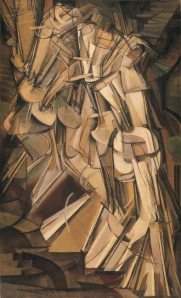 umbrella, it concentrated mostly on time, similar to a long exposure of a camera setting. In his selection of works, “Nude descending a staircase” is perhaps the most well-known, having a great composition, backed up by the strong, confident use of line and colour. This was seen as a step in the wrong direction for cubism and was rejected by the community. Duchamp was of course disheartened, but did not give up on art. In fact, this can be seen as the most important turning point in his work.
umbrella, it concentrated mostly on time, similar to a long exposure of a camera setting. In his selection of works, “Nude descending a staircase” is perhaps the most well-known, having a great composition, backed up by the strong, confident use of line and colour. This was seen as a step in the wrong direction for cubism and was rejected by the community. Duchamp was of course disheartened, but did not give up on art. In fact, this can be seen as the most important turning point in his work.
The artist began to produce ready-mades as artwork, found objects which formed the basis for the dada movement. The union of objects and the juxtaposition of them against one another is a reaction to the First World War, a form of protest art, and also something that rebelled against the boundaries of art. In some respects it can be seen as anti-art in its concept. This can be seen as an attempt to react against the society which did not agree with his earlier work and which had settled neatly into a predictable cubist world. In 1915 he moved to New York along with other artists who were both fleeing the war and this conventional groove. Possibly the most famous of his readymades was constructed during his time in New York.
In 1917, an artwork which was certainly never appreciated at the time and caused controversy throughout the art scene, Fountain was entered into an exhibition showcasing the avant-garde of new work in the New York area. It was discarded and disallowed by the panel, pushing Duchamp and his companions out of the increasingly popular art world. This piece is, without a doubt, one of the most significant pieces of art not only in the twentieth century, but ever. It paved the road for the legacy of Duchamp, who soon became one of the most respected artists in New York. Duchamp and his close friend Man Ray wrote New York Dada, a compendium and manifesto to what the movement meant, which was hugely influential to artists at the time, and many artists flocked to the new epicentre of art. Amidst the prowess and thriving art scene in the states, Duchamp focussed on what he considers his most important work “The Bride Stripped Bare by her Bachelors, Even (The Large Glass)” which he worked on for eight years, and then his final twenty years were spent working on a 3-dimensional version of the piece. It is so
in the New York area. It was discarded and disallowed by the panel, pushing Duchamp and his companions out of the increasingly popular art world. This piece is, without a doubt, one of the most significant pieces of art not only in the twentieth century, but ever. It paved the road for the legacy of Duchamp, who soon became one of the most respected artists in New York. Duchamp and his close friend Man Ray wrote New York Dada, a compendium and manifesto to what the movement meant, which was hugely influential to artists at the time, and many artists flocked to the new epicentre of art. Amidst the prowess and thriving art scene in the states, Duchamp focussed on what he considers his most important work “The Bride Stripped Bare by her Bachelors, Even (The Large Glass)” which he worked on for eight years, and then his final twenty years were spent working on a 3-dimensional version of the piece. It is so 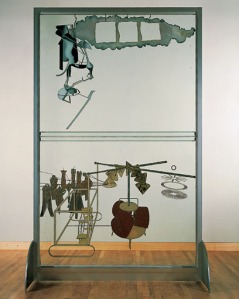 incredibly important because of its connection to the artist. Just imagine how much effort the artist put into the work. Duchamp overlooked this point though as it was unimportant to the final piece, instead he centred on the concept behind the art. The bride is isolated from the nine bachelors in the bottom screen, this can be interpreted as two things, one they are working for her, attempting to please her, this would mean it’s a satirical work were the female has complete power over the male gender. The second is that it is a kind of experiment, the removal of women from the world could lead to disastrous consequences, as males would have nothing to work for. Either way, the piece is without doubt strong. I believe the artist’s choice to think of this as his most vital work to be because of his connection with it and the effect and control the work had on his life (it did take him 28 years).
incredibly important because of its connection to the artist. Just imagine how much effort the artist put into the work. Duchamp overlooked this point though as it was unimportant to the final piece, instead he centred on the concept behind the art. The bride is isolated from the nine bachelors in the bottom screen, this can be interpreted as two things, one they are working for her, attempting to please her, this would mean it’s a satirical work were the female has complete power over the male gender. The second is that it is a kind of experiment, the removal of women from the world could lead to disastrous consequences, as males would have nothing to work for. Either way, the piece is without doubt strong. I believe the artist’s choice to think of this as his most vital work to be because of his connection with it and the effect and control the work had on his life (it did take him 28 years).
In all of his works, including the early works, he has asked the question what is art? He has questioned how art is viewed and how artists should approach making their artworks. Duchamp was the key player in the evolution of art towards its conceptual climax in the 1960s. He died in 1968 just outside Paris.
Continuing on from Duchamp’s idea, Piero Manzoni is an infamous artist who dealt with the growing celebrity trend by creating mass-produced items inspired by himself. He was born in Italy in 1933 and started working in white monochrome paintings during the early 1950s influence by Yves Klein’s work in the same way, but eventually moved on to what he is considered to be so important for. “Artist’s Shit” talks about the artists role 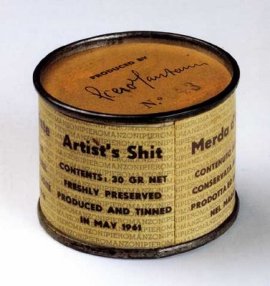 in the art world, dealing with the artist itself. It portrayed the art to be a futile act which was nowhere near as imperative as the artist. The tin was simple with the label reading “Artist’s shit,” the simplicity being crucial to the audiences understanding of the concept, the brutal wording emphasising the vulgarity of the work. This piece was a follow up to the successful “Artist’s breath” a balloon blown up by the artist. It, of course, has the same concept as the offensive tin. Jars of Angelina Jolie’s and Brad Pitt’s breath were recently sold in 2005 for $15099 on ebay. Maybe Manzoni was warning us of this impending celebrity obsessed culture we live in today. It also may have been a precursor for the skyrocketing art market in the nineties with art collectors such as Saatchi buying piece just for the sake of owning a piece by an important artist. He became a member of Milan’s Galeria Azimut, a meeting place for avant-garde artists which provided the art
in the art world, dealing with the artist itself. It portrayed the art to be a futile act which was nowhere near as imperative as the artist. The tin was simple with the label reading “Artist’s shit,” the simplicity being crucial to the audiences understanding of the concept, the brutal wording emphasising the vulgarity of the work. This piece was a follow up to the successful “Artist’s breath” a balloon blown up by the artist. It, of course, has the same concept as the offensive tin. Jars of Angelina Jolie’s and Brad Pitt’s breath were recently sold in 2005 for $15099 on ebay. Maybe Manzoni was warning us of this impending celebrity obsessed culture we live in today. It also may have been a precursor for the skyrocketing art market in the nineties with art collectors such as Saatchi buying piece just for the sake of owning a piece by an important artist. He became a member of Milan’s Galeria Azimut, a meeting place for avant-garde artists which provided the art  scenes daily dose of provocative and controversial works. The mundane becoming very valuable is a theme seen in the work of the Dadaists and Duchamp.
scenes daily dose of provocative and controversial works. The mundane becoming very valuable is a theme seen in the work of the Dadaists and Duchamp.
Although Manzoni was inspired by the past, he was fascinated with developing art and worked mostly in the sixties to form a base for the rest of conceptual art to bounce off of. Works such as his living sculptures piece, allowed the viewer to step on and become art. This was obviously a huge inspiration to Gilbert and George, who describe themselves as living sculptures. The artist was early on the art scene and unfortunately died before Sol Lewitt published his paragraphs on conceptual art, but yet he is still considered a conceptual artist. Why? Because of his clever use of humour in his works, his aspiration to break the boundaries between art genres, and of course his strong clear concepts. Mazoni died in 1963, and had created a ledge were other artists could continue his legacy.
Sol Lewitt, one of these artists which used Manzoni’s work as a grounding, was born in Connecticut, 1928. He worked as a graphic artist for, a now internationally renowned architect, I.M.Pei. As a young boy he was inspired by De Stijl and Bauhaus, influenced by its straight lines and design purpose. His earlier works were mostly of cubes organized in a structural arrangement until he saw the potential for furthering his art and moving into the conceptual world. He made up serial systems which provided ideas for his work, it systematically worked through all the outcomes with the inputs provided. This is especially true for “49 Three-Part Variations on Three Different Kinds of Cubes,” where he experimented with three different kinds of cube (open, closed, and half open) and found how many variations he could create with this. He published his findings of this new kind of art in his paragraphs on conceptual art in ArtForum, 1967:
all the outcomes with the inputs provided. This is especially true for “49 Three-Part Variations on Three Different Kinds of Cubes,” where he experimented with three different kinds of cube (open, closed, and half open) and found how many variations he could create with this. He published his findings of this new kind of art in his paragraphs on conceptual art in ArtForum, 1967:
“In conceptual art the idea or concept is the most important aspect of the work. When an artist uses a conceptual form of art, it means that all of the planning and decisions are made beforehand and the execution is a perfunctory affair. The idea becomes a machine that makes the art.”
This extract resembles very closely how Lewitt worked with his art, he was extremely isolated from it. This involved even getting other people to produce his work for him, while he wrote the plans. This was particularly evident in his wall drawings phase where Lewitt would compose a set of instructions and give them to a draughtsman who would then follow the plans to his best of knowledge and thus the artwork would be created. This ingenious form of working allowed Lewitt to produce vast amounts of clever systematic pieces, which like his work before used a logical pattern to 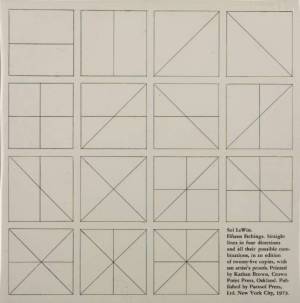 attain its final state. This serial method may have been inspired by the repetition of tanks and soldiers from the Vietnam war and the mass produced objects in the consumerist market that existed at the time. Pop artists such as Andy Warhol had already looked into this, much like Manet had done during the late nineteenth
attain its final state. This serial method may have been inspired by the repetition of tanks and soldiers from the Vietnam war and the mass produced objects in the consumerist market that existed at the time. Pop artists such as Andy Warhol had already looked into this, much like Manet had done during the late nineteenth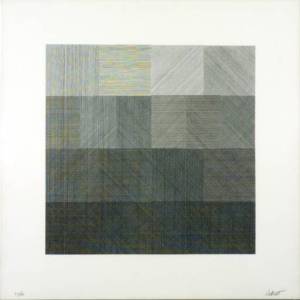 century, and now Lewitt was, but in a much more conceptual way, obscuring it beyond the obvious. Lewitt worked from the late sixties into the modern day with large concrete structures resembling his earlier work. However he died recently in April 2007. He was extremely important in the expansion of conceptual art, not just for his findings but how he highlighted the work behind the art is just as important as the final piece. Knowing this, he placed his plans beside the work as to give them equal credit. He was also significant in continuing on Duchamps ready-made idea where the artist does not have to produce the actual work.
century, and now Lewitt was, but in a much more conceptual way, obscuring it beyond the obvious. Lewitt worked from the late sixties into the modern day with large concrete structures resembling his earlier work. However he died recently in April 2007. He was extremely important in the expansion of conceptual art, not just for his findings but how he highlighted the work behind the art is just as important as the final piece. Knowing this, he placed his plans beside the work as to give them equal credit. He was also significant in continuing on Duchamps ready-made idea where the artist does not have to produce the actual work.
Michael Craig Martin, another conceptual artist who regarded Duchamps ready-made idea as hugely crucial to the development of art, has been a hugely influential artist in the ways in which he approaches his concepts. He was also in later years a lecturer of Goldsmiths, where the Young British Artists originated from. He was born in 1941 in Ireland but moved to America at an early age and studied painting at Yale University. Whilst in America he would have been influenced by the American art scene, which was flourishing with all the migrant artists from Europe. This hub for art  would be incredibly important in Craig-Martin’s interest in art. Upon completing his degree in 1966 he moved to England where he still works. In 1973 he taught as a senior lecturer at Goldsmiths college, London, where he had huge influence over students during the 1980s and 90s. His part was pivotal in the forming of the YBAs, publicising the Freeze exhibition and guiding the artists into their proper directions. His work, although conceptual in content, is very inspired by
would be incredibly important in Craig-Martin’s interest in art. Upon completing his degree in 1966 he moved to England where he still works. In 1973 he taught as a senior lecturer at Goldsmiths college, London, where he had huge influence over students during the 1980s and 90s. His part was pivotal in the forming of the YBAs, publicising the Freeze exhibition and guiding the artists into their proper directions. His work, although conceptual in content, is very inspired by  minimalism. His simple use of simple, household objects can be seen as a modern equivalent of Duchamp’s ready-mades. Possibly the most famous of these works is “Oak Tree” a glass of water on a shelf, with a plaque next to the piece dictating the artists argument that the glass of water on the shelf is in fact, an oak tree. His reasoning is that because he is the artist, he can change the glass into an oak tree. This brought up questions of how the artists intent was an extremely important issue of the time. Because of his use of domestic items, the art is relatable and reads easily and correctly, having conceptual lucidity.
minimalism. His simple use of simple, household objects can be seen as a modern equivalent of Duchamp’s ready-mades. Possibly the most famous of these works is “Oak Tree” a glass of water on a shelf, with a plaque next to the piece dictating the artists argument that the glass of water on the shelf is in fact, an oak tree. His reasoning is that because he is the artist, he can change the glass into an oak tree. This brought up questions of how the artists intent was an extremely important issue of the time. Because of his use of domestic items, the art is relatable and reads easily and correctly, having conceptual lucidity.
The artist did not constrict himself to these pieces and worked on installations, sculptures, paintings, wall drawings and many others. Craig-Martin remains a very famous and influential artist, working mostly in screen prints and large painted wall murals. These pieces can be seen as a kind of modern pop art. In one of these works entitled “History” the artist juxtaposes scale and objects to create a nonsense which although can be seen as unorganized comes across as graphical and neat in appearance. This clinical sense may be implying something about our organized society or how history is portrayed in the present. Despite what it actually means, his work can be seen as very contemporary, even though it heavily references pop art and its mass production. It is extremely difficult to use a technique that has been used before and have it emerge looking new.
Two artists which have applied this technique to Manzoni’s living sculptures are Gilbert and George, a united duo, who work together. They are made up of Gilbert Proesch who was born in Italy, 1943 and George Passmore in Devon, 1942. Although nothing has ever been openly discussed over their relationship, it is widely considered that they are a couple. They met at Saint Martins College of Art and Design in 1967 after it  turned out George was the only one who could understand Gilbert’s poor English. Their studios consist of a room entirely dedicated to subject matter. In it are boxes and boxes of things, filed in order in A4 sized boxes. In another room is a computer studio devoted to the creation of sketches on the computer. This clinical setting is very similar to the way in which the artists function. All of their pieces are entitled as sculptures, even if they are 2-Dimensional (this maybe a reference to Duchamp’s attempt to break down the barriers of the genres). They work in mixed media with photographs mostly with a trademark format of a rectangle or square broken down into a grid. But their degree show piece for Saint Martin’s was not dissimilar to Manzoni’s living sculptures idea. Gilbert and George dressed up in suits and stood on a podium like base, depicting themselves as living sculptures. In the film “A portrait of the artists as young men, 1970” the artists are filmed doing nothing for seven minutes. The concept behind this work was the same as the living sculptures idea. This developed into their entire body of work, and everything they do is now an extension of the personas they have created
turned out George was the only one who could understand Gilbert’s poor English. Their studios consist of a room entirely dedicated to subject matter. In it are boxes and boxes of things, filed in order in A4 sized boxes. In another room is a computer studio devoted to the creation of sketches on the computer. This clinical setting is very similar to the way in which the artists function. All of their pieces are entitled as sculptures, even if they are 2-Dimensional (this maybe a reference to Duchamp’s attempt to break down the barriers of the genres). They work in mixed media with photographs mostly with a trademark format of a rectangle or square broken down into a grid. But their degree show piece for Saint Martin’s was not dissimilar to Manzoni’s living sculptures idea. Gilbert and George dressed up in suits and stood on a podium like base, depicting themselves as living sculptures. In the film “A portrait of the artists as young men, 1970” the artists are filmed doing nothing for seven minutes. The concept behind this work was the same as the living sculptures idea. This developed into their entire body of work, and everything they do is now an extension of the personas they have created  for themselves. The two appear in suits whenever in public and very rarely are seen apart. These guises, are the vital part to their work as everything they do stems out from it, they are the central them of their work. Although moving into their later work, the artists included religion, sexuality, alcohol, class, nationality, death, identity and politics as themes in their work. In “The Naked Eye, 1994” the artists are depicted without their iconic suits, completely naked but still hiding behind their hands. This can be seen as a portrayal of the loss of character that the two feel when they are not in character.
for themselves. The two appear in suits whenever in public and very rarely are seen apart. These guises, are the vital part to their work as everything they do stems out from it, they are the central them of their work. Although moving into their later work, the artists included religion, sexuality, alcohol, class, nationality, death, identity and politics as themes in their work. In “The Naked Eye, 1994” the artists are depicted without their iconic suits, completely naked but still hiding behind their hands. This can be seen as a portrayal of the loss of character that the two feel when they are not in character.
In 1984 the pair were nominated for the Turner Prize only to lose to fellow artist, Malcolm Morley. They did win in 1986 however. They have been very important artists throughout their careers broadening the horizons of what art is and how it is portrayed to the public. They drew the art away from the actual art and more towards the artist, a technique used by Piero Manzoni in his work. The artists believe firmly that their art breaks down the social barriers of society, and I believe this too. Because of their light heartedness and almost confessional work they really appeal to me.
Although many people do not like conceptual art, it must be argued that it has been one of the most dramatic and important turns in art. The expansion of art makes it easier for an artist to work in whichever way he or she feels comfortable. It was crucial to what art has become nowadays, and I shudder to think what would have happened if the movement had not occurred.
Bibliography
Introduction
http://www.tate.org.uk/collections/glossary/definition.jsp?entryId=73
Marcel Duchamp
http://www.tate.org.uk/modern/exhibitions/duchampmanraypicabia/rooms/default.shtm
http://www.tate.org.uk/servlet/ViewWork?workid=4029
Nude descending staircase no2, 1912
The Bride Stripped Bare by her Bachelors, Even (The Large Glass), 1915-1923
Fountain, 1917, all pictures supplied by tate.com
Piero Mazoni
http://www.tate.org.uk/servlet/ViewWork?cgroupid=999999961&workid=26872&searchid=9599
http://www.tate.org.uk/servlet/ViewWork?cgroupid=999999961&workid=27330&searchid=12749
http://www.artpool.hu/ketseg/5-1-2/artist/MANZONI.html
http://www.abc.net.au/news/newsitems/200506/s1390036.htm
artist’s shit, 1961, supplied by artpool.hu
artists breath, 1960, supplied by tate.com
Sol Lewitt
http://www.oberlin.edu/amam/exhibit_simpleforms.htm
http://radicalart.info/concept/LeWitt/paragraphs.html
Both wall drawings supplied by tate.com
49 Three-Part Variations on Three Different Kinds of Cubes (1967–71) – supplied by Allen Memorial Art Museum online
Michael Craig Martin
http://www.michaelcraig-martin.com/
http://www.artnet.com/artist/4547/michael-craig-martin.html
Oak Tree, 1973, supplied by tate.com
History, 2001, supplied by artnet.com
Gilbert & George
www.artlex.com/ArtLex/c/collaboration.html
http://www.tate.org.uk/britain/turnerprize/history/gilbertgeorge.htm
http://www.tate.org.uk/modern/exhibitions/gilbertandgeorge/
Still from a portrait of the artists as young men, 7 minutes long, supplied by tate.com
Naked Eye, 1994, supplied by tate.com
Gordon Douglas 16th February 2009